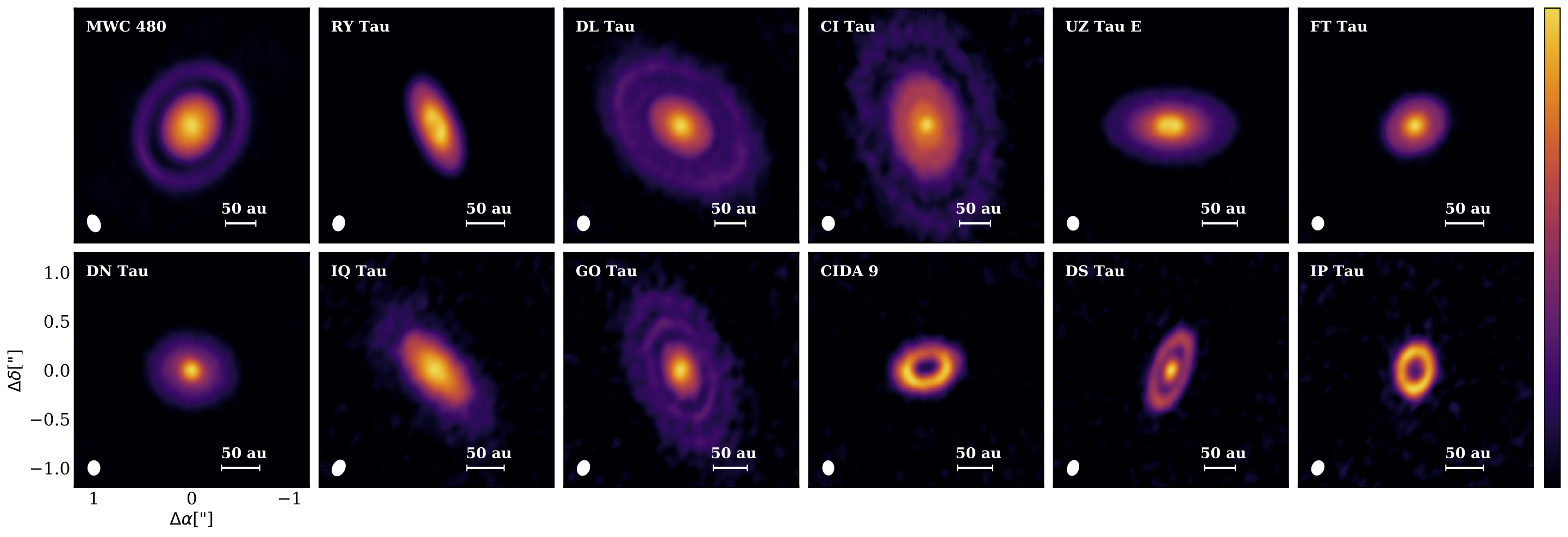Disk Small-scale Substructures
The striking image of HL Tau from the ALMA Science Verification observation in 2014 has opened up the window of observational planet formation at its earliest stage. The revealed features with dust gaps and rings can naturally explain the long-standing radial drift barrier in planet formation and facilitate the build-up of young planets. Questions like in what forms, how prevelence, how diverse, disk substructure are, remain to be answered with surveys towards disk samples spanning sufficient parameter space. Works towards their origins and detailed consequences for planet formation has just started.
Our Taurus survey serves as one of the earliest explorations towards a sample view of disk substructures. We have performed a high-resolution (~0.1”) ALMA survey (Cycle 4, PI. Herczeg) at 1.3 mm for a sample of 32 disks with spectral type earlier than M3 in Taurus Clouds. Follow-up observations for a sub-sample has then conducted at the longer 3 mm with comparable angular resolution (Cycle 6, PI. Long). Key results include:
1) Dust substructures are prevalent, observed in 1/3 of our sample, mostly seen as axisymmetric rings and gaps; Long, F., Pinilla, P., Herczeg, G. J, et al. ApJ 2018 ; Liu, Y., Dipierro, G., Ragusa, E. et al. A&A 2019

2) The correlation between gap locations and widths, the intensity contrast between rings and gaps, and the separations of rings and gaps could all be explained if most gaps are opened by low-mass planets (super-Earths and Neptunes) with low viscosity; see also Lodato, G., Dipierro, G., Ragusa, E., Long, F. et al. ApJ 2019
3) The gap locations are not well correlated with the expected locations of CO and N2 ice lines, so condensation fronts are unlikely to be a universal mechanism to create gaps and rings.
4) The similar dust emission morphology at 1.3 and 3 mm for three ring disks imply the presence of pressure bumps at outer disk, which could be created by planet-disk interactions. Dust rings, with high density and enhanced grain growth, however, serve as the promising sites for the formation of new planets; Long, F., Pinilla, P., Herczeg, G. J, et al. ApJ 2020
On-Going Work
As follow-ups for this survey, we are now extending our studies to disks around low-mass M-dwarfs to obtain a more complete picture of substructure emergence, as well dedicated efforts to characterize compact disks (more representative of the bulk disk population) with the best resolution we can currently achieve with ALMA.
We have also started to explore how the presence of substructures can affect disk evolution and planet formation (e.g., affect inner disk chemistry with dust rings at large disk radii, Banzatti, A. et al. ApJ 2021).
With so many efforts devoted to the substructure characterzation on young embedded disks (eDISK large program) and young Class II disks (e.g., DSHARP), we recently proposed a high-resolution survey towards (accepted) more evolved disks in Upper Sco to look for signs of substructure evolution and the possible link to planet growth/migration.
Relavent Observing programs
- VLA-20B-342/21B-141 (PI. Feng Long) - to explore dust ring properties towards the optically thin regime
- ALMA-2022.1.00646S (PI. Feng Long) - to study substructure evolution with Upper Sco disks
- ALMA-2022.1.00828S (PI. Feng Long) - 2-3au view of small faint disks (the more representative disk sample)
- ALMA-2021.1.00854S (PI. Feng Long) - high-resolution view of disks that will be mapped by JWST for inner disk chemistry
- ALMA-2019.1.00607S/2021.1.01050S (PI. Feng Long) - look into those small bright disks in Taurus
- ALMA-2018.1.00614S (PI. Feng Long) - Band 3 follow-up on three ring disks to test dust trapping
- ALMA-2016.1.01164S (PI. Greg Herczeg) - initial Taurus Survey